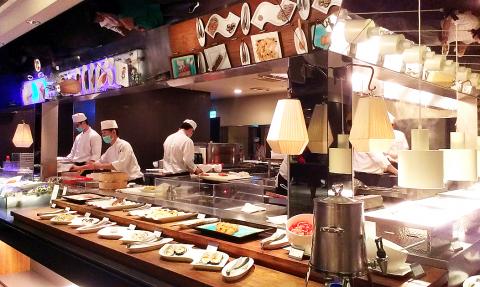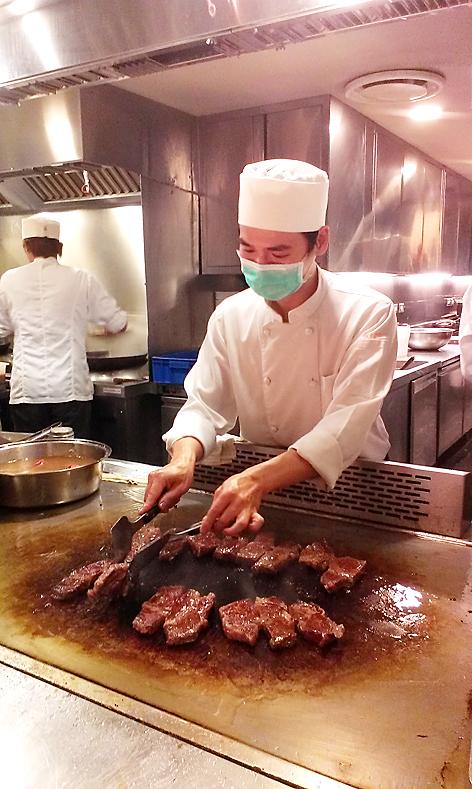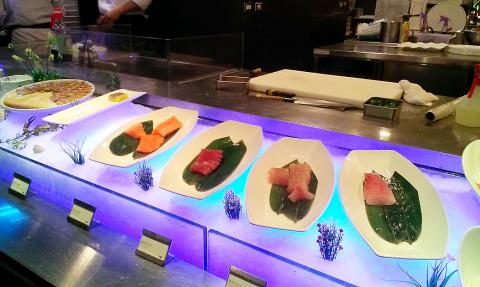Eat Together (饗. 食天堂) is a franchise buffet restaurant that brings together a reasonable number of foods commonly found in Taipei all on one floor. Japanese, Chinese, European and Taiwanese dishes were among those I spotted last weekend when I visited this minor miracle of human engineering. The meal is a little pricey, but judging by the crowd, clearly not a great deterrent.
At the Q Square location (京站店), located close to the Taipei Main Station, each of the 352 seats was occupied when we arrived, and there was an hour-long wait at the door. Reservations, especially on weekends, are strongly advised.
During the interlude, my companions and I admired the interior’s marble floors and clean lines, which open up into chambers of food: sushi bar, salad bar, meat carving station and multiple panels of cakes and hot dishes. Once inside, we found a secret warren stocked with fruits and a dessert fondue.

Photo: Enru Lin, Taipei Times
Put another way, this is a huge space. But the service is impeccable, in spite of the seemingly boundless ground to cover. Moments after finishing the food on my plate, the neighborhood busser was right there to take it away.
On the buffet circuit, I encountered more staff, all of them friendly and impressively vigilant. It only takes a moment to receive a plate of designer sushi, or to have a family-sized bowl of curry hotpot or clam soup fired up on a stove range right in front of you.
And I was surprised by the quality of Eat Together’s sirloins, which are cooked to order and laid out tenderly on a plate by a strapping lad with a spatula. These little ones are a main event — juicy and blessedly fatty — and pair well with the milk-soaked pineapple that is offered alongside.

Photo: Enru Lin, Taipei Times
On the serve-it-yourself range, many of the dishes are of a quality you would expect from a meal at a business restaurant. A frying station serves up tempura prawns that are fresh, long and luxuriously battered. The German roast pork knuckle has a nice hard crust that gives way to buttery tenderness, and the baby potatoes are sweet and creamy.
Another panel features creative dishes in a tiny cup, the ingredients of which look as though they were arranged with tweezers. Some, like the single scallop on miso wasabi sauce and greens, brightened with a triangle of red bell pepper, were tasty. Others were strange, like the bacon cake doused with mayonnaise and herbs. The texture took its cue from fresh rice cake, but had a powerful fleshy flavor that made it hard to chew.
Throughout the meal, it was not easy to hear over the industry of the open kitchens, or that of fellow diners rushing about. So dinner conversation could probably never get romantic, or even very friendly: You must lean in, and sometimes shout.

Photo: Enru Lin, Taipei Times
Meanwhile, waiters circulate slowly to collect the bill in advance — we met ours about 40 minutes into the meal. She was firm, almost heroically so, and like us had to raise her voice above the din. While she said nothing to prompt our leaving, at least one at my table felt hurried and overlooked the finer points of Eat Together’s baked desserts, which were mostly made from scratch and looked beautiful. I helped myself to a bowl of Meiji and Haagen-Dazs ice cream, which are available in counters by the fondue section. In the end, I left Eat Together satisfied with the quality of the fare and feeling full, but was just a little glad that the excitement was over.

Photo: Enru Lin, Taipei Times

That US assistance was a model for Taiwan’s spectacular development success was early recognized by policymakers and analysts. In a report to the US Congress for the fiscal year 1962, former President John F. Kennedy noted Taiwan’s “rapid economic growth,” was “producing a substantial net gain in living.” Kennedy had a stake in Taiwan’s achievements and the US’ official development assistance (ODA) in general: In September 1961, his entreaty to make the 1960s a “decade of development,” and an accompanying proposal for dedicated legislation to this end, had been formalized by congressional passage of the Foreign Assistance Act. Two

Despite the intense sunshine, we were hardly breaking a sweat as we cruised along the flat, dedicated bike lane, well protected from the heat by a canopy of trees. The electric assist on the bikes likely made a difference, too. Far removed from the bustle and noise of the Taichung traffic, we admired the serene rural scenery, making our way over rivers, alongside rice paddies and through pear orchards. Our route for the day covered two bike paths that connect in Fengyuan District (豐原) and are best done together. The Hou-Feng Bike Path (后豐鐵馬道) runs southward from Houli District (后里) while the

Mirror mirror on the wall, what’s the fairest Disney live-action remake of them all? Wait, mirror. Hold on a second. Maybe choosing from the likes of Alice in Wonderland (2010), Mulan (2020) and The Lion King (2019) isn’t such a good idea. Mirror, on second thought, what’s on Netflix? Even the most devoted fans would have to acknowledge that these have not been the most illustrious illustrations of Disney magic. At their best (Pete’s Dragon? Cinderella?) they breathe life into old classics that could use a little updating. At their worst, well, blue Will Smith. Given the rapacious rate of remakes in modern

March 31 to April 6 On May 13, 1950, National Taiwan University Hospital otolaryngologist Su You-peng (蘇友鵬) was summoned to the director’s office. He thought someone had complained about him practicing the violin at night, but when he entered the room, he knew something was terribly wrong. He saw several burly men who appeared to be government secret agents, and three other resident doctors: internist Hsu Chiang (許強), dermatologist Hu Pao-chen (胡寶珍) and ophthalmologist Hu Hsin-lin (胡鑫麟). They were handcuffed, herded onto two jeeps and taken to the Secrecy Bureau (保密局) for questioning. Su was still in his doctor’s robes at